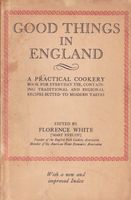Advertisement
General Rules for Roasting
Appears in
Published 1932
- If you have a fire before which it is possible to roast, but have no spit or jack, two strong skewers put through the middle of the roast, one on each side with a strong piece of string tied round each end will do the trick. (This is a hint for campers, hikers and backwooders. Sir
Walter Scott writing in 1820, in Ivanhoe says: ‘Wild fowl brought in upon small wooden spits or broaches, “drip their fatness from the hazel broach’”). - It is a good plan to turn the bird or joint upside down half way through the roasting process, so that the juices may be more evenly distributed. If skewered in the middle this can be achieved quite easily; with the old-fashioned horizontal revolving spit this was not necessary. It was the perfect method of roasting.
- Before putting meat down to roast (or cook in any other way) joint it properly, preserve the fat by covering it with paper which should be tied on with fine twine (skewers let out the gravy, therefore too many should not be used). If there is more fat than you think will be eaten with the lean trim it off, for it will make an excellent pudding if finely chopped; or ‘render’ (melt) it down and clarify it for frying.
- Put some dripping in the pan, baste the meat well at once, and every 15 minutes till the last half-hour; then take off the paper, sprinkle a little salt over the joint, baste it well with a little butter and dredge it with flour; let it cook for a few minutes longer till the froth arises then take it and dish it up.
- Slow roasting is as advantageous to the tenderness and flavour of meat as slow boiling, of which everybody understands the importance. The warmer the weather and the longer the meat has hung the less time it will require to roast it.
- Roasting should be done by the radiant heat of a clear glowing fire; meat may be ‘roasted’ in an oven or in a pot over the fire, but in both these cases it is in fact baked.


